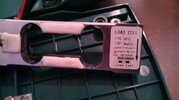Captain*kirk
Member
Any of you guys using the CM1500...as you probably know, there are a bunch of 'field mods' including the McDonald's Straw Mod (or now available as a bushing insert) as well as a number of speed setting alterations that can be done. Personally, I'm pretty happy with the way my CM works right out of the box. I'd like to hear from anyone who has modded theirs, whether or not you think it's helped, and what made you do the mods?



